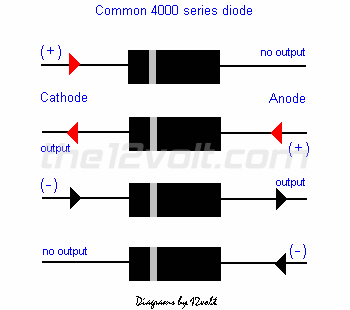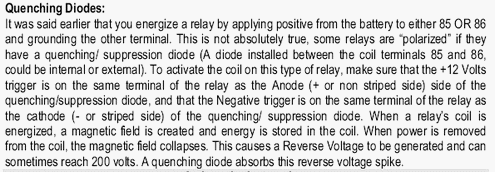What’s the Reason to Diode Isolate?
Printed From: the12volt.com
Forum Name: Car Security and Convenience - Hot Topics
Forum Discription: Stickied topics from our Car Security and Convenience forum. Car Security and Convenience FAQs. Read First!
URL: https://www.the12volt.com/installbay/forum_posts.asp?tid=86348
Printed Date: April 19, 2024 at 9:21 PM
Topic: What’s the Reason to Diode Isolate?
Posted By: bqe.
Subject: What’s the Reason to Diode Isolate?
Date Posted: November 28, 2006 at 4:32 PM
Why is it necessary to diode isolate a glass break sensor and motion sensor if there not connected to the door sensor?
Replies:
Posted By: kgerry
Date Posted: November 28, 2006 at 4:50 PM
feedback will keep them both on often....
-------------
Kevin Gerry
Certified Electronics Technician
MECP First Class Installer
Owner/Installer
Classic Car Audio
since 1979
Posted By: bqe.
Date Posted: November 28, 2006 at 5:51 PM
Can u explain how and why the feedback would occur without any of the sensor's being triggered? Thanks
Posted By: bsd1
Date Posted: November 29, 2006 at 12:06 PM
If both sensors are connected to a dedicated (not shared with door trigger) sensor input (same zone) of your brain, logically that doesn't matter because your brain can't identify which is which when it's triggered.
When they are connected together to the door trigger, for instance, feedback can cause your domelight to be on unexpectedly. Other than that, isolation with diode doesn't make much sense.
Say I connected hood and trunk triggers to the same input, same zone violation appears on your 2-way remote display anyway.
Posted By: KarTuneMan
Date Posted: November 30, 2006 at 3:57 AM
A diode STOPS both a NEG(-) signal and a POS(+) signal from going in a certain direction....depending on the placement of the diode. 
In some cases....bigger IS better... -------------
Posted By: evois
Date Posted: November 30, 2006 at 11:41 AM
taking this diagram as correct, why is it that if you use an ohmmeter it shows continuity if I use the (+) of the ohmmeter to the (+) of the # 1 diagram and the (-) of the ohmmeter to the (-) of the diagram? Is it because electricity travels (-) to (+)?
Posted By: jpease
Date Posted: November 30, 2006 at 10:38 PM
anyone know a good place to buy diodes online used for automotive security online and what should I buy. Link?
Posted By: evois
Date Posted: December 01, 2006 at 6:55 AM
it's easily accessible, at radioshack.
Posted By: dea,can
Date Posted: December 03, 2006 at 2:51 AM
 ------------- dragon
Posted By: jpease
Date Posted: December 04, 2006 at 9:42 AM
evois] wrote:
t's easily accessible, at radioshack.
anyone have a part number/sku? or link?
Posted By: evois
Date Posted: December 04, 2006 at 12:18 PM
jpease wrote:
evois] wrote:
t's easily accessible, at radioshack.
anyone have a part number/sku? or link?
I used the 1N4001
Posted By: bqe.
Date Posted: December 04, 2006 at 4:50 PM
Posted By: tvic
Date Posted: December 05, 2006 at 12:13 PM
An ohmeter across a diode will show continuity for many reasons, as it could be the circuit on the other end of that + and - are still continuous. (i.e. even across the + / - of a transformer will still show continuity). Show just because hooking an ohmeter across a + and a - shows minimal resistance, or beeps, that doesn't mean there's a short across the device.
Posted By: dualsport
Date Posted: December 05, 2006 at 10:18 PM
evois] wrote:
taking this diagram as correct, why is it that if you use an ohmmeter it shows continuity if I use the (+) of the ohmmeter to the (+) of the # 1 diagram and the (-) of the ohmmeter to the (-) of the diagram? Is it because electricity travels (-) to (+)?
Usually with a DMM you will hook up the red (+) lead to the side without the stripe, and the black (-) to the side with the stripe. With the meter on the diode check range (which puts out a high enough voltage to allow the diode to start conducting), it should show a reading. If you reverse the leads, it shouldn't show anything, if it's working properly.
Some old analog meters are different, however, the polarity of the resistance measurement is backwards, where the black lead puts out a positive voltage relative to the red one. If so, then you need to connect the red to the striped cathode side of the diode to check it.
Posted By: jpease
Date Posted: December 11, 2006 at 9:16 AM
thanks guys! I appreciate your help.
Posted By: dualsport
Date Posted: December 12, 2006 at 12:02 AM
If you anticipate needing more than a few components, it'd probably be worth your while to order from mouser.com or digikey.com; the 1N4001 diodes there are about 2 cents each in quantities of 100.
Posted By: alexlloyd
Date Posted: December 21, 2006 at 6:27 PM
dea,can wrote:

Does this not appear to be backwards. Positive on the non-striped end and negative on the stripe forward biases the diode and it will conduct and effectively bypass the coil and not energize the relay. Refer to the diagram above. In order for the diode to quench the reverse spike generated when you remove the power from the relay, it would have to be reverse biased to energize it. That requires +12v on the stripe, ground on the other end.
Posted By: dualsport
Date Posted: December 21, 2006 at 11:35 PM
Yes, it should be the reverse of that description; it needs to always be reverse biased with the striped side connected to the higher voltage.
For a low side drive Trig(-) and high side drive Trig(+):

Posted By: jacqueslacombe
Date Posted: December 30, 2006 at 3:57 AM
4001 or 4004 should do this is good for 1 amp don't pay more than 10 cents a piece
-------------
cocolaboy
Posted By: dualsport
Date Posted: January 08, 2007 at 8:11 AM
1N4001 through 1N4004 are all rated for 1 amp, the only difference is that the higher numbers like 1N4004 are able to withstand a larger reverse voltage. You can always substitute a higher one for a lower one, so if you stock up on diodes, get the higher ones for the small diff in cost.
|


